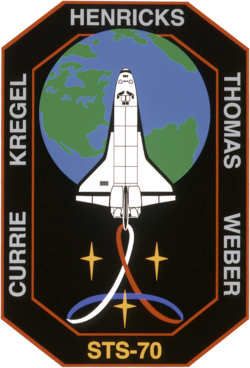STS-71
| STS-71 | |||||
 | |||||
| Uppdrag | ? | ||||
|---|---|---|---|---|---|
| Rymdfärja | Atlantis (14)[1] | ||||
| NSSDC-ID | 1995-030A[2] | ||||
| Färdens tid | 9 dagar, 19 timmar, 23 minuter, 9 sekunder | ||||
| Uppskjutning | |||||
| Startplats | Startplatta 39A vid Kennedy Space Center i Florida | ||||
| Start | 27 juni 1995, 19:32:19 UTC | ||||
| Landning | |||||
| Landningsplats | KSC, Runway 15 | ||||
| Landning | 7 juli 1995, 14:55:28 UTC | ||||
| Omloppsbana | |||||
| Varv | 153 st[3] | ||||
| Apogeum | 342 km | ||||
| Perigeum | 342 km | ||||
| Banlutning | 51,6° | ||||
| Sträcka | 6,6 miljoner km | ||||
| Dockning | |||||
| Rymdstation | Mir | ||||
| Dockning | 29 juni 1995, 13:00:16 UTC | ||||
| Dockningsport | Kristall | ||||
| Urdockning | 4 juli 1995, 11:09:42 UTC | ||||
| Tid dockad | 4 dagar, 22 timmar, 9 minuter 26 sekunder | ||||
| Besättning | |||||
| Befälhavare | Robert L. Gibson (5) | ||||
| Pilot | Charles J. Precourt (2) | ||||
| Uppdragsspecialister | Ellen S. Baker (3) Bonnie J. Dunbar (4) Gregory J. Harbaugh (3) | ||||
 | |||||
| Kronologi Rymdfärjeprogrammet | |||||
| |||||
STS-71 var en uppskjutning i det amerikanska rymdfärjeprogrammet, den fjortonde med rymdfärjan Atlantis. Den sköts upp från Pad 39A vid Kennedy Space Center i Florida den 27 juni 1995. Efter nästan tio dagar i omloppsbana runt jorden återinträdde rymdfärjan i jordens atmosfär och landade vid Kennedy Space Center.
Atlantis blev den första rymdfärja att docka med rymdstationen Mir. Man dockade med Kristall-modulen, som för tillfället flyttats från sin normala plats på stationen, detta för att man skulle slippa dra ihop ett antal solpaneler på stationen.
Norman Thagard sköts upp med Sojuz TM-21 och landade med STS-71.
Se även
Referenser
- ^ NASA Space Shuttle Launch Archive Arkiverad 29 mars 2015 hämtat från the Wayback Machine., läst 28 juli 2016.
- ^ ”NASA Space Science Data Coordinated Archive” (på engelska). NASA. https://nssdc.gsfc.nasa.gov/nmc/spacecraft/display.action?id=1995-030A. Läst 20 mars 2020.
- ^ Manned Astronautics - Figures & Facts Arkiverad 26 september 2015 hämtat från the Wayback Machine., läst 28 juli 2016.
Externa länkar
 Wikimedia Commons har media som rör STS-71.
Wikimedia Commons har media som rör STS-71.
| ||||||||
| |||||||||||||
| ||||||||||||||||||||||||||||||||
Media som används på denna webbplats
Författare/Upphovsman: Pascal (Flickr user: pasukaru76), Licens: CC0
Vostok spacecraft replica at the Technik Museum Speyer, Germany.
MIR Space Station Emblem
The crew assigned to the STS-71 mission included (front left to right) Vladimir N. Dezhurov, Mir 18 crew download; Robert L. Gibson, commander; and Anatoly Y. Solovyev, Mir 19 crew upload. On the back row, left to right, are Norman E. Thagard, Mir 18 crew download; Gennadiy Strekalov, Mir 18 crew download; Gregory J. Harbaugh, mission specialist; Ellen S. Baker, mission specialist; Charles J. Precourt, pilot; Bonnie J. Dunbar, mission specialist; and Nikolai Budarin, Mir 19 crew upload. Launched aboard the Space Shuttle Atlantis on June 27, 1995 at 3:32:19.044 pm (EDT), the STS-71 mission marked many firsts in human space flight history. It was the first U.S. Space Shuttle-Russian Space Station Mir docking and joint on-orbit operations, and the first on-orbit change out of a shuttle crew. In addition, it was the largest spacecraft ever in orbit and was the 100th U.S. human space launch conducted from the Cape.
STS-70 Mission Insignia
The STS-70 crew patch depicts the Space Shuttle Discovery orbiting Earth in the vast blackness of space. The primary mission of deploying a NASA Tracking and Data Relay Satellite (TDRS) is depicted by three gold stars. They represent the triad composed of spacecraft transmitting data to Earth through the TDRS system. The stylized red, white, and blue ribbon represents the American goal of linking space exploration to the advancement of all humankind.
STS-67 Mission Insignia
STS-71 Mission Insignia
The STS-71 crew patch design depicts the orbiter Atlantis in the process of the first international docking mission of the Space Shuttle Atlantis with the Russian Space Station Mir. The names of the 10 astronauts and cosmonauts who flew aboard the orbiter are shown along the outer border of the patch. The rising sun symbolizes the dawn of a new era of cooperation between the two countries. The vehicles Atlantis and Mir are shown in separate circles converging at the center of the emblem symbolizing the merger of the space programs of the two space faring nations. The flags of the United States and Russia emphasize the equal partnership of the mission. The joint program symbol at the lower center of the patch acknowledges the extensive contributions made by the Mission Control Centers (MCC) of both countries. The crew insignia was designed by aviation and space artist, Bob McCall, who also designed the crew patch for the Apollo Soyuz Test Project (ASTP) in 1975, the first international space docking mission.









